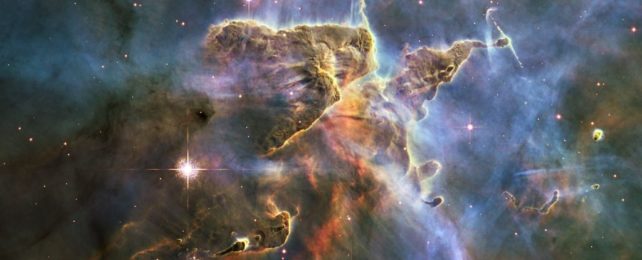An analysis of the most energetic light in the galaxy has revealed we may be mistaken about star formation rates in the Milky Way.
Gamma rays produced by the radioactive decay of isotopes produced during star formation reveal that stars are forming at a rate of four to eight times the mass of the Sun per year. That may not seem like a lot, but it's two to four times more than current estimates, suggesting that our home galaxy isn't quite as quiescent as we had thought.
And this has important implications for our understanding of the evolution of our galaxy, and those around us, since the rate at which stars are born and die can alter a galaxy's overall chemical composition.
A paper describing the finding, led by astrophysicist Thomas Siegert of the University of Würzburg in Germany, has been accepted for publication in Astronomy & Astrophysics, and is available on preprint server arXiv.
Stars are the factories that produce our Universe's more complex elements. Their cores are nuclear furnaces, smashing atoms together to forge them into ever larger atoms. When they die, their violent death throes spew these heavier elements into interstellar space, to drift in clouds or be taken up in new stars that are forming. Their supernova explosions, too, are energetic, forging even heavier elements that their cores could not support.
Like their deaths, star births are also energetic. They form from dense clumps in clouds of interstellar dust and gas, collapsing under gravity and greedily slurping up material from the space around them until there is enough pressure and heat in their cores to ignite fusion. As they do so, they start to emit powerful stellar winds blowing particles out into space, and jets launched from their poles of particles accelerated along the baby star's magnetic field.
One element known to result from star death is a radioactive isotope of aluminum called aluminum-26. Aluminum-26 doesn't last long, cosmically speaking; it has a half-life of 717,000 years. And as it decays, it produces gamma radiation at a specific wavelength.
But aluminum-26 is also present in significant quantities in the clouds of material that surround newly forming stars. If the velocity at which material falls into a star exceeds the speed of sound, a shock wave forms, generating cosmic rays. As the rays collide with isotopes in the dust, such as aluminum-27 and silicon-28, they can produce the isotope aluminium-26.
So, by looking at the budget of gamma radiation in the Universe produced by the radioactive decay of aluminum-26, astronomers can estimate the rate at which stars that generate the isotope form and die in the Milky Way, and use that to determine an overall rate of star generation.
Current estimates for the star formation rate of the Milky Way galaxy sit at around two Suns' worth of material converted into stars every year. Since most stars in the Milky Way are a lot less massive than the Sun, that's estimated to be on average around six or seven stars annually.
Siegert and his colleagues took a census of the aluminum-26 gamma radiation in the galaxy, and conducted modeling to see the most likely production mechanism for the observed abundance of this light. They found that the best fit is a star formation rate of around four to eight solar masses per year; or up to roughly 55 stars per year.
There's still room for improvement on this estimate; the models did not quite reproduce the Milky Way's gamma radiation as it is currently observed; and the distance of the gamma ray source could alter the final estimate, but is tricky to gauge. This is why the researchers could only give a range for the star formation rate, rather than a pinpointed mass.
However, the team's method shows promise for better understanding how the Milky Way makes new stars. Star formation is usually shrouded in thick gas and dust that is difficult to see into; counting up the gamma radiation it produces could be one effective way of peering behind the curtain.
The team's research has been accepted for publication in Astronomy & Astrophysics, and is available on arXiv.
